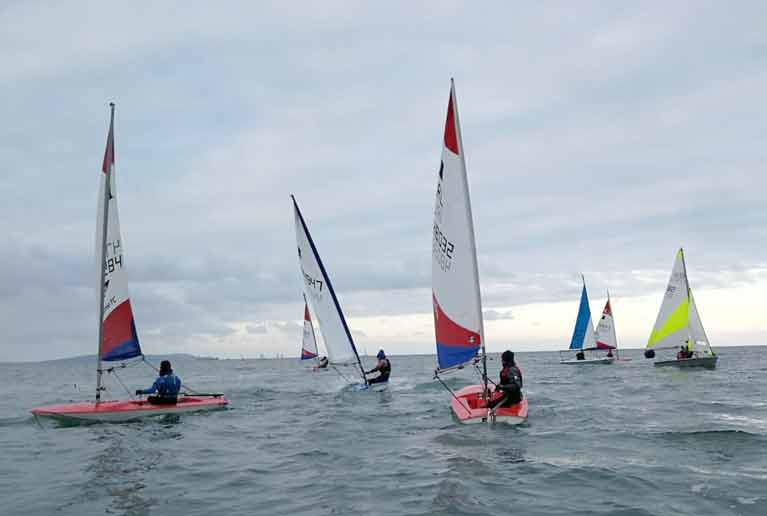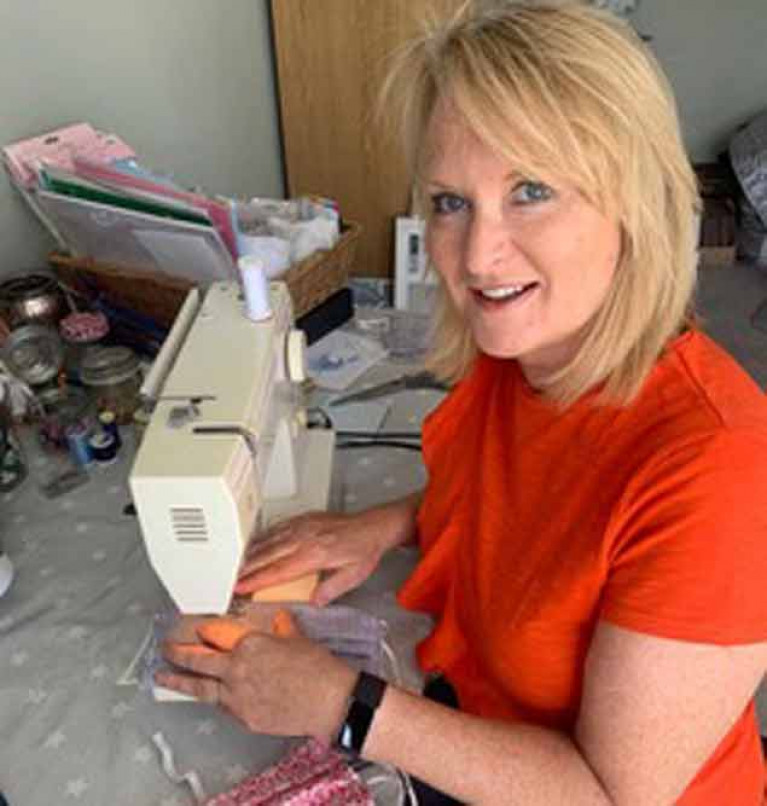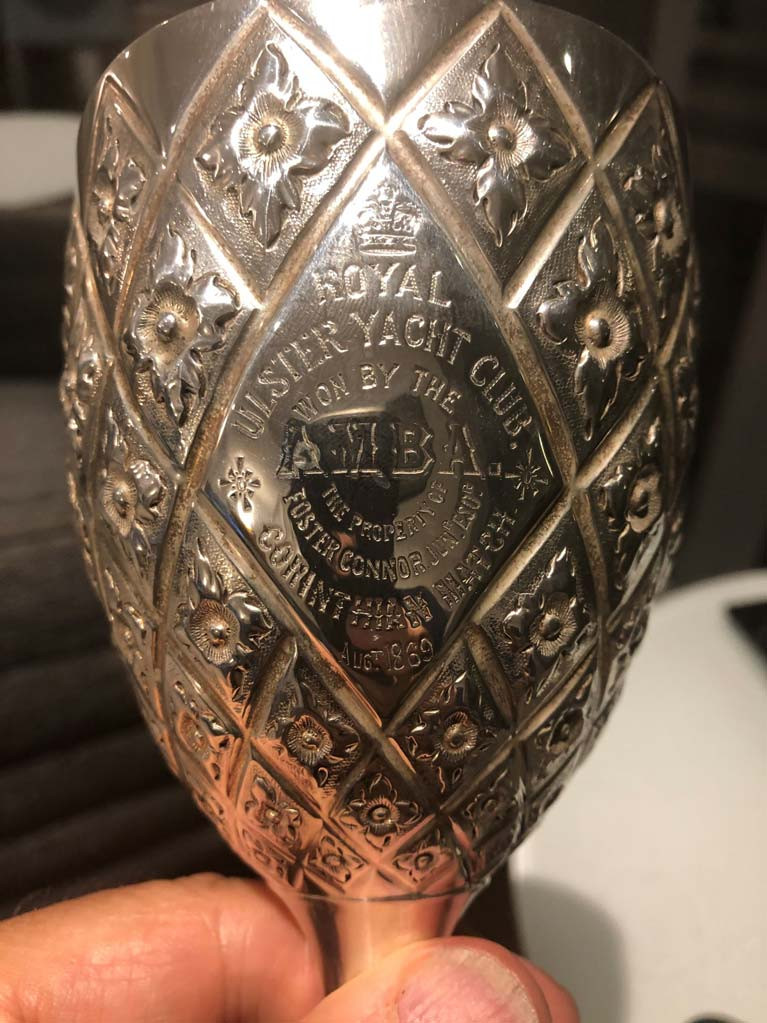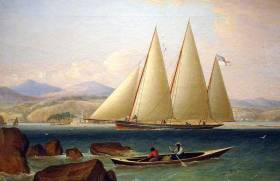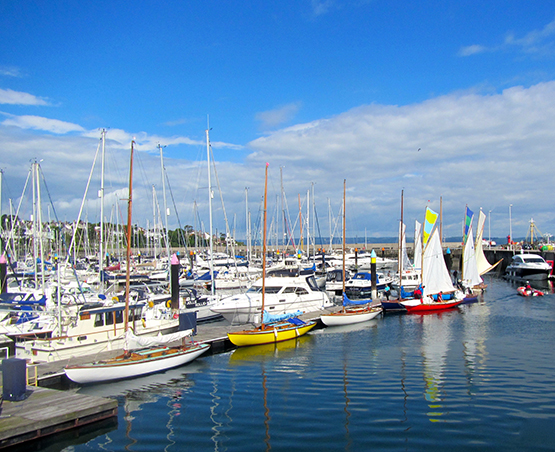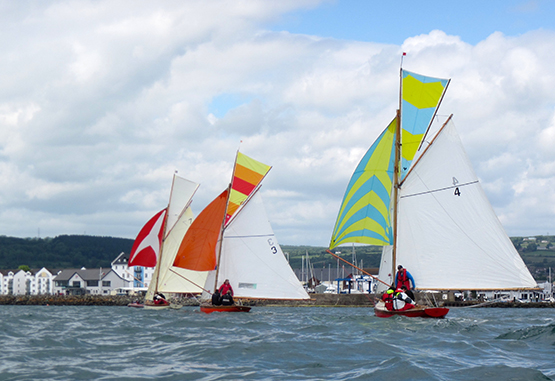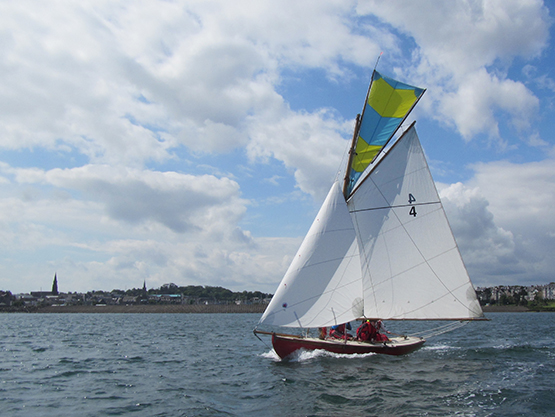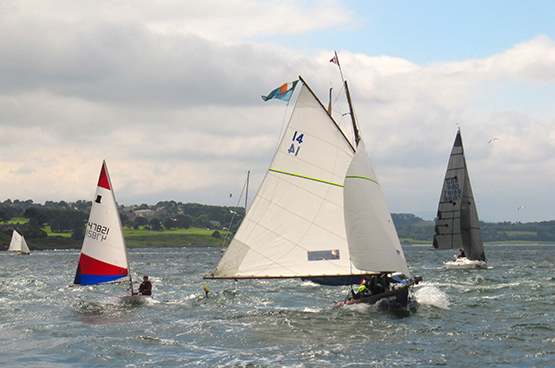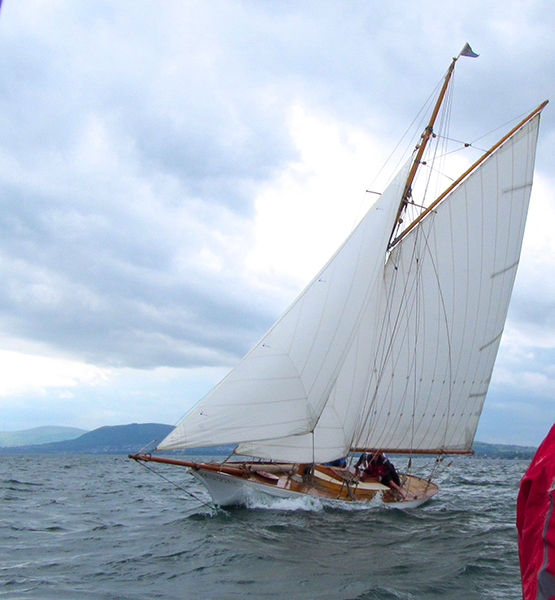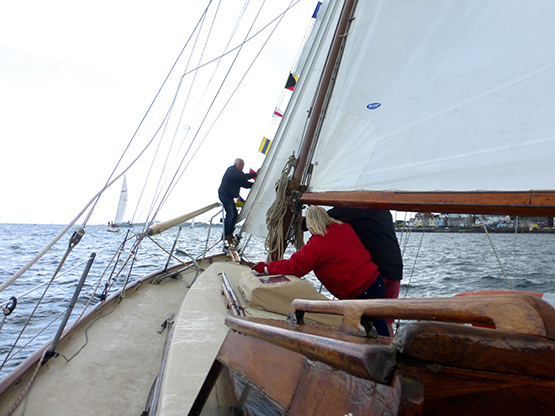Displaying items by tag: Royal Ulster Yacht Club
Full Steam Ahead for Sailing in Bangor on Belfast Lough
Neighbouring clubs Royal Ulster and Ballyholme at Bangor in County Down on Belfast Lough are both due back on the water soon.
The RUYC sailing committee has decided that in line with further guidance from the RYA that competitive sport can’t start until the 17th July at the earliest, that the club will start sailing on the Saturday 18th July in the first of a series of Round Belfast Lough type courses. In August a new one round the Copeland Islands is planned. The updated sailing programme and sailing instructions for the new series of races will be available here www.ruyc.co.uk on 10th July.
Thursday night racing has been cancelled for this month (July) but as events are moving very quickly now, the August points racing will be reviewed should there be a further easement. The annual Regatta will now not be possible this Saturday (11th) as competitive sailing cannot happen until later in the month. It is hoped that a smaller-scale event will be held during September.
Short cruises in company around Belfast Lough are on the books with a start this Sunday (12th) with a short trip to Helens Bay where anchoring is possible.
Sailing Secretary Jim Coffey said “The sailing committee would like to thank members for their patience and understanding whilst we try and work our way through these difficult times; ultimately the safety of members is paramount as the pandemic is still with us".
At Ballyholme the bar will open this evening (9th)with drinks served outside with the now usual restrictions. See Ballyholme.com
And there is good news for cadets. Paul Prentice RTC (Recognised Training Centre) Principal is delighted to be able to run courses. “ Thanks to our dedicated training team, with support from RYANI, we are delighted to release our Programme for 2020”. He adds “ As you will see there are a number of changes to the format, and unfortunately, due to restrictions we are unable to offer beginners courses.
The team is excited to welcome you back on the water”.
Courses are available to book, for Members only until Friday 17th July, after which they will be opened to non-members. Please take some time to read the information online and particularly the cancellation policy and ifIf you have any questions or concerns, please give Lyn a call at the club on 028 9127 1467.
Royal Ulster Yacht Club to Open Doors on Friday
The opening up of Royal Ulster Yacht Club on Belfast Lough has been long-awaited and tomorrow (Friday 3rd July) is the big day.
During the past week bar and waiting staff have undergone training on the new way of working. As members will appreciate life cannot return to normal just yet so restrictions will be in place initially and the situation will be reassessed weekly. But for at least this weekend and the next the Club will only be open on Friday lunchtime and evening, Saturday evening and Sunday lunchtime for dining. There will initially be only a limited menu as the head chef is stranded in Poland but as soon as he returns – in the middle or to the end of July, depending on quarantining rules - the menu will be extended again.
To accommodate the numbers, social distancing is important and for the smooth running of the service, tables can only be booked with at least 24 hours’ notice and at most 10 days before the desired date and members will be given a fixed time to arrive. And to accommodate as many as possible two sittings will be trialled . Also, initially bookings will only be accepted for members and members of their households. Pre- or post-dinner drinks will be served at the table as the bar itself which will be screened. The dining room will be zoned, and each zone will have a dedicated waiter or waitress. This is to limit the possibility of cross contamination and aid tracing if there should be an outbreak at the Club
For those wishing to buy drinks without a meal, this can only be accommodated outside and will be table service only. Booking will not be required for this, but it is expected names and contact details for track and trace purposes will be required.
There will be sanitisation stations throughout the clubhouse and entry and exit will be through the front door with a limited one-way system into and out of the front bar.
In common with many other businesses, the club is trying to discourage the use of cash so bar and dining bills will be paid by card.
Rear Commodore Maurice Butler said he can see the light at the end of the tunnel “ While clearly, it will take several more months to see a return to something near normal hopefully it will not be too long before sailing can get underway in earnest.
In the meantime, the Club is planning short-handed crew races and day cruises in which family groups from the one household can participate. It is unfortunate that with the delay since March of being able to get access to their yachts some owners will not have the necessary work done in sufficient time to make it worthwhile launching their boats this year. I do believe that 2020 will go down as the strangest sailing season on record. We all hope fervently that it will never be repeated!”
Royal Ulster Yacht Club Members Produce Items for NHS
At this time of furlough and time filling, some Royal Ulster Yacht Club members on Belfast Lough decided not to squander an opportunity and found they could turn their hands to producing items for the NHS and friends.
Claire Storey, in response to a post from groups making scrubs, borrowed a sewing machine and with help and guidance from a neighbour started sewing. She began with scrubs made from bed linen donated by friends and managed to make the best of the great weather and sewed in the garden. Her scrubs went to the Covid Paediatric and A&E Wards in the Royal Victoria Hospital in Belfast. Claire’s husband has asked her to make face masks for his office staff when they return to work, and she will be donating some to friends. The masks are not for not suitable for front-line workers but adequate otherwise.
 Claire Storey's scrubs
Claire Storey's scrubs
Mae and Walter Burke have set up a duet production line assembling much-needed visors. Friends had told them that a joinery firm in Bangor, Dougan Contracts, were making visors and they offered to help assemble them. Walter says the most difficult part is the headbands, but it has not deterred them from producing several hundred. The face shields are distributed free of charge to local frontline health workers.
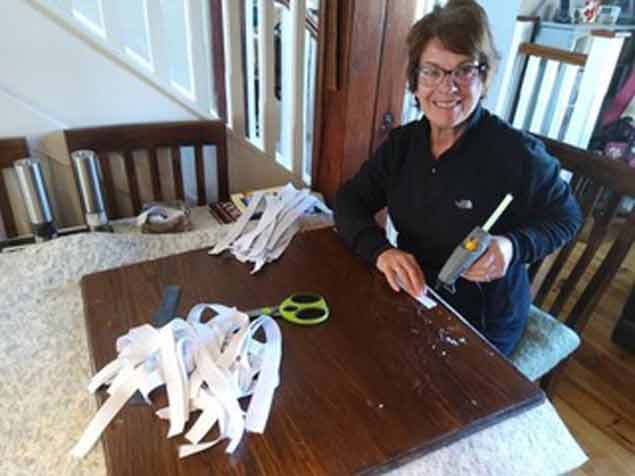 Mae Burke
Mae Burke
Also making face masks for friends and family is Barbara Polly, who manages to fit production in with her day job as a nurse in a local surgery. She borrowed a sewing machine from her mother in law and makes them on her days off.
These are just a few of an army of volunteers producing items for the NHS and friends.
Royal Ulster Yacht Club Buys Goblet Found in Australia
Although the mystery of how a Goblet inscribed Royal Ulster Yacht Club, dated 1869 and awarded to a Mr Foster Connor, ended up in Melbourne (Read Afloat's earlier report here) has not been resolved, the trophy has been bought by the club and is now in a glass cabinet in the Gloucester Room.
Mr Connor was a wealthy Belfast linen merchant with a home called Seacourt on Wilson’s Point in Bangor overlooking the Lough. He was Rear Commodore of RUYC in 1884 and owned the Amba. It would appear that he gave his name to some buildings in Bangor – Connor House School and the Connor Wing of the local hospital.
Given the significance of the date, this is likely to be the oldest cup in existence bearing the Club’s Royal name. Its size may disappoint as cups awarded for club races in those days were mainly “keepers” rather than perpetual challenge cups!
Royal Ulster Yacht Club Goblet - Could Afloat Readers Solve This Australian Mystery?
Recently Royal Ulster Yacht Club was contacted by a Mr Andre Jaku of Melbourne, Australia about a goblet he had bought from Leonard Joel’s Auction house in the city.
It was listed as silver and was engraved with the words:
Royal Ulster Yacht Club
Won by the AMBA The property of Foster Connor Jun Esq.
Corinthian Match Aug 1869
It appears slightly repaired on the stem and there is a small mark on the bottom. I understand from the club historian, Ed Wheeler, that it is the trophy for the race between Amba owned by Mr Connor and Mr John Currell’s Flirt.
According to the Club history, Foster Connor seems to have become a member in 1869 and this was the year in which the Club received its Royal warrant (ie its name changed from the Ulster Yacht Club to the Royal Ulster Yacht Club). Interestingly, this did not come officially into force until a meeting on 14th October at which the warrant was received and the name change took place. So, the date on the goblet, August 1869, precedes the date on which the Club became RUYC, so the inscription may be misleading, although the trophy could have been awarded and inscribed after the warrant was formalised.
Connor’s 9-ton cutter Amba and John Currell’s 7-ton cutter Flirt seem to have been the leading protagonists.
 The RUYC Trophy with an Australian twist
The RUYC Trophy with an Australian twist
Ed Wheeler reveals that Currell and Connor were having some kind of feud at the time and at a committee meeting a letter was read out from Foster Connor, in which he declined to accept the jurisdiction of the “three gentlemen who proposed to decide a question in dispute on that occasion”. At the meeting, he said that the Protest Committee was not properly constituted because not all of the Sailing Committee had been invited and of the three who were, two were brothers, so he would not abide by their decision. Mr. Richard Patterson then said that, before the race started, Mr. Connor had told him that he would not be bound by any decision the race committee might make; he then said that the reason they agreed to go before the two members on the committee after the race was because they were sure that the decision would go in their favour.
Connor was Rear Commodore of RUYC in 1884 and his son, Charles C Connor held the same position in 1891. Although the details of the race for which the cup was awarded in 1869 are not known, the following year a similar race took place. This was a “Corinthian” race, meaning a race for amateur sailors only, for yachts of 10 tons or under. Cups awarded for club races in those days were mainly “keepers”, rather than perpetual challenge cups, which is why the cup is marked as Foster Connor’s property.
/more
There are several occasions in which a Mr Foster Connor is mentioned in records.
And from those he would appear to have been a wealthy man, owning two residences, one in Belfast and a grand mansion called Seacourt which he built at Wilson’s Point on the west of Bangor Bay. In the Dept of Communities Historic Buildings it is included as “A grand symmetrical, classically-styled, two-storey three-bay house over concealed basement, built c.1865, located to the north side of Bangor, overlooking the sea and in 1860 the Journal of the Society of Arts named Foster Connor and Co as one of the six principal linen manufacturers in Belfast. He was also a keen yachtsman. (Journal of Society of Arts; Hunt’s Yachting Magazine) Connor died in 1881 and the house then passed to his son Charles C Connor”
In a Belfast Street Directory, he is listed as a linen merchant and yarn merchant with a residence in Linenhall Street, Belfast.
Connor is buried with other family members in the Belfast City Cemetery with an 8ft high headstone described as a
Memorial to the Foster Connor (died 5th December 1881 aged 70 years) as well as other members of his family.
Foster Connor was a wealthy linen merchant who lived in Belfast but also had the fine residence Seacourt built for him at Wilson's Point, Bangor.
So, the question is how did the goblet come to be in Melbourne?
Sailing's Gaff Rig: Ireland's Part in its Downfall
The 35th staging of international races for the 176-year-old America’s Cup is rising rapidly up the agenda. The opening jousts for challengers begin on 26th May 2017 at the first-time-selected venue of Bermuda, and the cup series itself starts there on 17th June. It’s time to focus on the sailing paradise of Bermuda, and particularly its role in changing the shape of sails in mainstream sailing. W M Nixon takes a typically skewed look at what it all might mean.
The irony of it is that, long before the rig was popularly accepted, it was the sailors of Bermuda who were credited with the invention of the jib-headed triangular shape for mainsails. This dominated yacht design for nearly a century. Yet in 2017, as the inevitably trend-setting America’s Cup finally comes to Bermuda for the first time, it will be raced by sailing machines – the word “boats” seems inadequate – which are setting what looks very like an extremely modern variation of the classic gaff rig.
For what are today’s state-of-the-art square-headed mainsails other than an attempt to get as much sail area as possible within the limits set by the height of the mast and the length of the boom? And what rig was based on the same premise? Exactly. The gaff rig, and its very useful cousin, the sprit rig.
 Is this or is this not gaff rig? America’s Cup defenders Oracle in action off San Francisco
Is this or is this not gaff rig? America’s Cup defenders Oracle in action off San Francisco
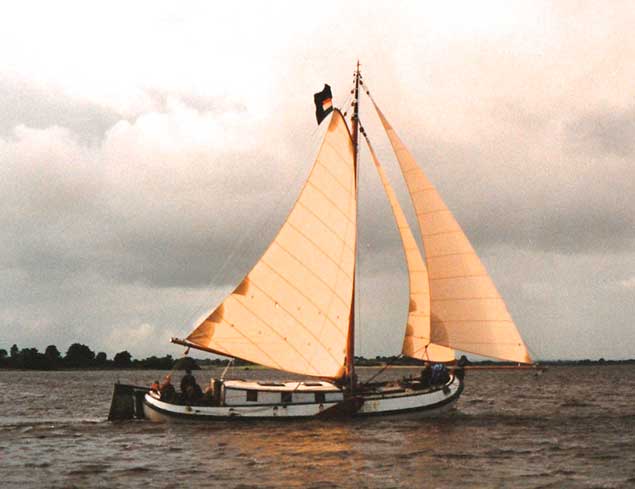 David Beattie’s Dutch Lemsteraak Schollevaer, sailing here on Lough Ree, indicates that classic Dutch yachts tended towards shortening their gaff booms to such an extent that for a period they were almost Bermudan rigged. Photo: W M Nixon
David Beattie’s Dutch Lemsteraak Schollevaer, sailing here on Lough Ree, indicates that classic Dutch yachts tended towards shortening their gaff booms to such an extent that for a period they were almost Bermudan rigged. Photo: W M Nixon
Yet at a certain stage, as the pioneering Dutch yachtsmen moved from the sprit rig to the gaff rig, the gaff booms became so short that the sailing world was very close to having jib-headed mainsails. But boats setting bisquine rig or something very similar showed what could be done with topsails, and longer gaff booms with topsails above them became the norm.
In due course, the logic of having lighter masts, and mainsail and topsail one and the same with no booms between them, became inescapable. Yet because so many people, relatively speaking, had by this time taken up sailing, the arguments about which rig, gaff or Bermudan, was superior soon became ludicrously heated.
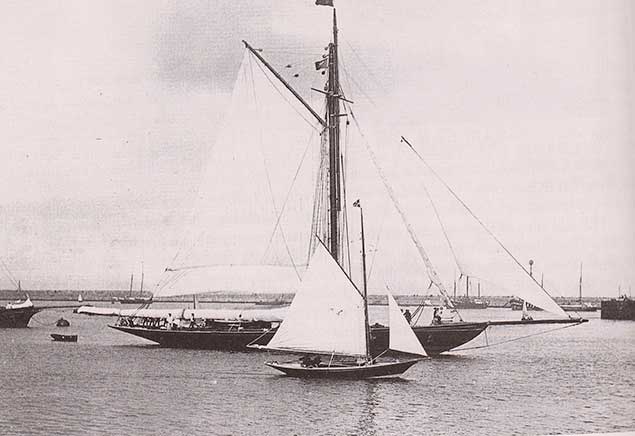 The Prince of Wales cutter Britannia in Dun Laoghaire in 1893, newly-built and on passage from the Clyde to the Solent, showing how a racing gaff rig could be shortened down for sea-going passages in heavy weather, with the topmast safely housed and a loose-footed gaff-headed trisail set instead of the full mainsail.
The Prince of Wales cutter Britannia in Dun Laoghaire in 1893, newly-built and on passage from the Clyde to the Solent, showing how a racing gaff rig could be shortened down for sea-going passages in heavy weather, with the topmast safely housed and a loose-footed gaff-headed trisail set instead of the full mainsail.
Traditionalists argued that while Bermudan rig might be just about acceptable for inshore racing in sheltered water, anyone going cruising or racing offshore needed the rugged gaff rig with its compact mast, possibly heightened by a topmast which could he lowered and housed against the forward side of the mainmast when at sea and conditions deteriorated.
And then there were and still are the uber-traditionalists who argue that if gaff rig had been good enough for their fathers and forefathers before them, then it was good enough for them, and you don’t have to go any further than Howth, Connemara or Falmouth to find them in their droves.
A new factor entered the equation with the development of the heritage industry, which concluded that that the loss of familiarity with handling the formerly-universal gaff rig was a real cultural threat. So in 1963 the Old Gaffers Association came into being at much the same time as the Classic Yacht Movement was starting to gain traction, and thus the preservation of gaff rig was being upheld from both ends of the wealthy to barely-getting-by spectrum.
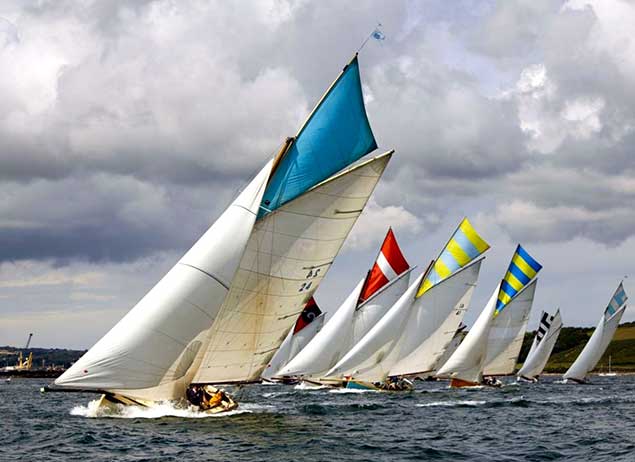 Where gaff rig is the norm – Falmouth Working Boats racing. Under ancient legislation, it is only permissible to dredge for oysters in Falmouth Harbour under sail, and the working boat with adjustable performance has developed as a result.
Where gaff rig is the norm – Falmouth Working Boats racing. Under ancient legislation, it is only permissible to dredge for oysters in Falmouth Harbour under sail, and the working boat with adjustable performance has developed as a result.
It was all great fun if you didn’t take it took seriously, but in its day, some people took it very seriously indeed and a few still do, so we’ll give the pot a very good stir by revealing that it was Irish sailors who played a key role in making Bermudan rig mainstream.
Our header image reveals that Bermudan rig in a quite sophistcated form was not unknown from 1834 onwards. But nevertheless even in crack yachts like Belfast linen magnate John Mulholland’s schooner Egeria of 1865 vintage, and John Jameson of Dublin’s cutter Irex designed by Alexander Richardson in 1884, the relatively crude gaff topsails being set still showed how closely they were descended from lug rigs which in turn had evolved from trying to get simple squaresails to set closer to the wind.
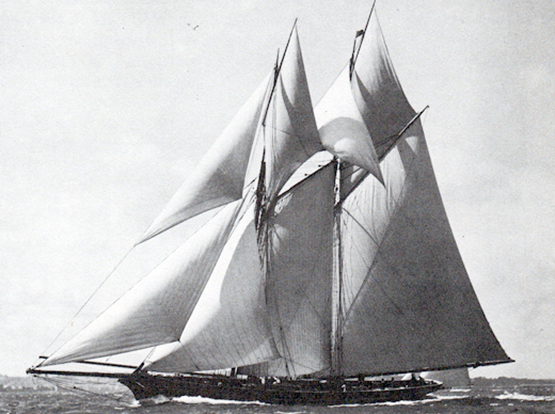 John Mulholland’s 99ft schooner Egeria of 1865 vintage set topsails which were developments of lug sails
John Mulholland’s 99ft schooner Egeria of 1865 vintage set topsails which were developments of lug sails
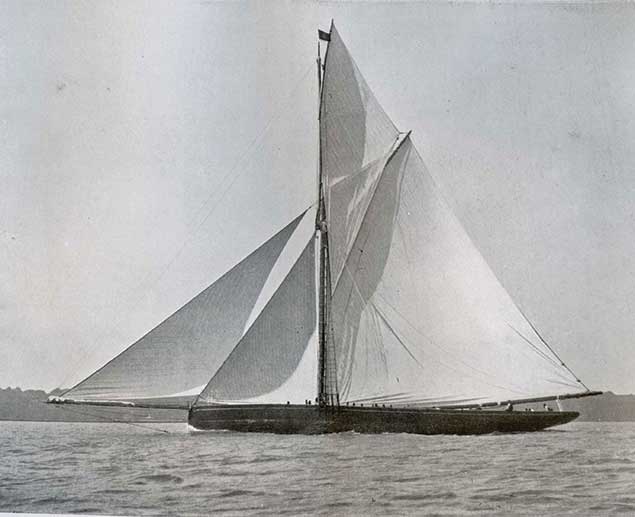 John Jameson’s Irex of 1884 originally set a topsail which looked very out-of-date just ten years later
John Jameson’s Irex of 1884 originally set a topsail which looked very out-of-date just ten years later
But by the late 1880s, topsails were becoming more clearly jib headed, and for a while they used a combination of short mainmast, a short topmast, and a topsail yard to provide their height, which could resulted in a distinctly stunted look when on a dead run, as is seen in the Scottish ironmaster Peter Donaldson’s all-conquering 70ft 40-rater Isolde, designed and built by Fife in 1895.
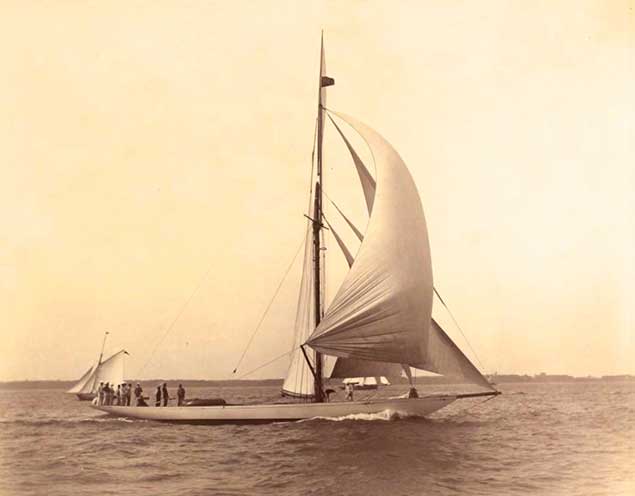 Fast boat, dumpy rig? Peter Donaldson’s successful Isolde of 1895 looked to have a very low-slung rig when she squared off on the run
Fast boat, dumpy rig? Peter Donaldson’s successful Isolde of 1895 looked to have a very low-slung rig when she squared off on the run
It is the famous photo of the new Belfast Lough 25ft One Designs at their start in the RUYC Regatta in July 1898 - their second season – which best shows how gaff rig had developed in the decade since Irex was the boat to beat. The BLOD 25’s have topsails which use long yard to sit as flush as possible with the mast. As the luff length of the topsail was actually longer than the luff length of the mainsail, and as it is luff length which does most of the work in making to windward, getting the topsail and mainsail to set as one was vital in achieving best performance.
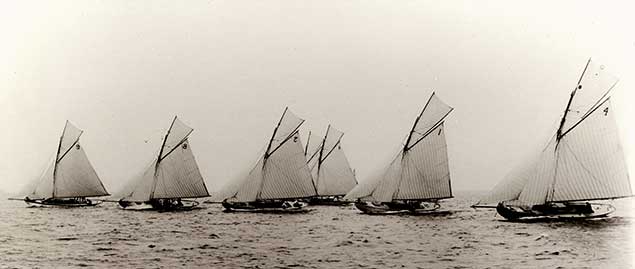 Serious topsails. With a luff length longer than the luff length of the mainsail, the Belfast Lough 25ft ODs had to get the set of their topsails just right.
Serious topsails. With a luff length longer than the luff length of the mainsail, the Belfast Lough 25ft ODs had to get the set of their topsails just right.
In fact, as I learned in my days of racing a Howth 17, fractions of an inch in the location of the topyard halyard and jackyard outhaul on their respective yards made all the difference between having a very effective topsail, and having a heap of rubbish aloft which was only holding you back if the wind freshened on the final leg. You were getting there if, when setting the sails, you could look aloft and see the newly-hoisted topsail set as flat as a board, with even tensions to every corner. This meant that you could ease the mainsail peak halyard just a smidgin to transfer some of the load directly to the topsail, thereby making mainsail and topsail in effect into one sail which happened to have a couple of bits of wood in the middle.
However, despite the favourable impact made by boats such as Isolde and the BLOD 25s, larger yachts tended increasingly to revert to long topmasts in order to make their topsails more effective, and in the most enthusiastic cases, the mastman would be despatched aloft to lace the luff of the topsail to the topmast and the mast itself. This certainly achieved an efficient set for the sail, but was unseamanlike in the extreme, as it totally obviated the topsail’s supposed benefit of being able to reduce sail area aloft in only a few minutes.
Surprisingly enough, it wasn’t until 1912 that designer Charles E Nicholson was allowed by an owner to do away with the cumbersome, eddy-inducing topmast altogether, simply by extending the mainmast in the lightest possible section in a 12 Metre.
Naturally the critics expected the new unfeasibly tall masts to break under the load of the topsails, and some of them did just that. But those tall continuous masts that stayed aloft tended to win races, and so the Marconi mast was here to stay. They were nicknamed “Marconi” masts in acknowledgement of the high aerials required by Italian radio pioneer Guglielmo Marconi (1874-1937), whose mother was a Jameson and whose first radio report of a sporting event was the Royal St George YC Regatta of 1904 in Dublin Bay.
It was only two years after the first Marconi sailing mast appeared in a yacht that the first international racing yacht took the next logical step of making the topsail and mainsail into one, and that yacht was newly-commissioned in 1914 from Fife of Fairlie by an Irish yachtsman, Arthur F Sharman Crawford, Commodore of the Royal Munster Yacht Club on Cork Harbour.
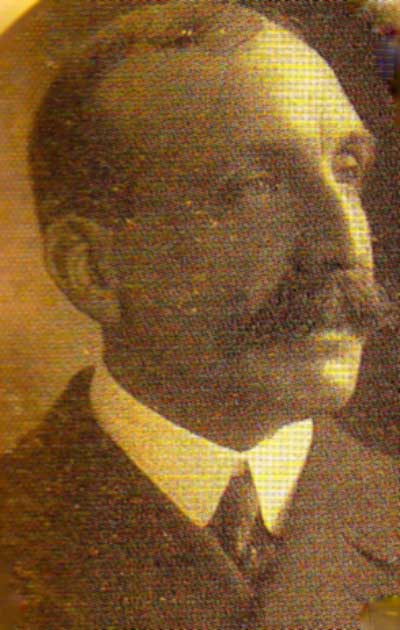 Man of many talents and interests – Arthur F Sharman Crawford contributed much to his adopted home of Cork
Man of many talents and interests – Arthur F Sharman Crawford contributed much to his adopted home of Cork
There’s a book to be written about Arthur F Sharman Crawford (1862-1943), for there’s no way that even a dozen blogs could explain how the Dublin-born English-educated younger son of a northern family with extensive land-holdings in County Down – particularly on the shores of Belfast Lough – came to be the Managing Director of Beamish & Crawford’s brewery in Cork. There, he joined the management team at the age of 28 in 1890, and guided it as Managing Director through some of its most successful periods, and also skillfully negotiated the difficulties of World War 1, the Easter Rising, the War of Independence and the Civil War in a total period from 1914 to 1923, while at the same time being a great benefactor to his adopted city, particularly in the area of technical education, but also in the broader cultural and artistic sphere.
Yet this was no unduly serious do-gooding workaholic. On the contrary, Arthur Sharman Crawford (the family preferred their double surname without a hyphen) was sports mad. A keen yachtsman who was an early owner in the Cork Harbour One Designs of 1896, he was elected Commodore of the Royal Munster YC when it was still at Monkstown in 1898. When it moved to Crosshaven in 1923, as he lived at Lota Lodge in Glanmire north of the harbour, he transferred his full allegiances to the more conveniently located Royal Cork at Cobh where he was already Vice Admiral, and in 1925 he became Admiral and served in that post until 1935.
He also rode to hounds every winter with ferocious enthusiasm, being Joint Master of Cork’s United Hunt for four years. And in later life he played a central role in the establishment of Cork Golf Club, where he served as an actively and frequently-playing President for many years. But in his prime, sailing was his main sport, and he spread his wings far beyond Cork Harbour, for he campaigned on the international scene with a Fife 12 Metre called Ierne, and as a member of many yacht clubs throughout Ireland and Britain, he was a frequent guest helm at regattas, with particularly close associations with the Royal Ulster YC on Belfast Lough.
There, his older brother Robert was Vice Commodore and chaired the committee which oversaw the five challenges for the America’s Cup by Thomas Lipton, the first in 1899 and the last in 1930. The advice of the widely-experienced Arthur was regularly sought by this committee. Yet in other areas of life, there was a parting of the ways between the two brothers. In a time of political restlessness, the northern-based Robert Sharman Crawford was uncompromisingly unionist, and became an active leader in the Ulster Volunteer Force from 1912 onwards. But in the different mood of Cork, the southern-based younger brother had a more accommodating attitude towards Home Rule, reflected in the fact that he continued to play a public role in Cork life, and all his branch of the family were at their deaths buried in the family plot on Little Island in Cork Harbour rather than in the ancestral family lands at Crawfordsburn in County Down.
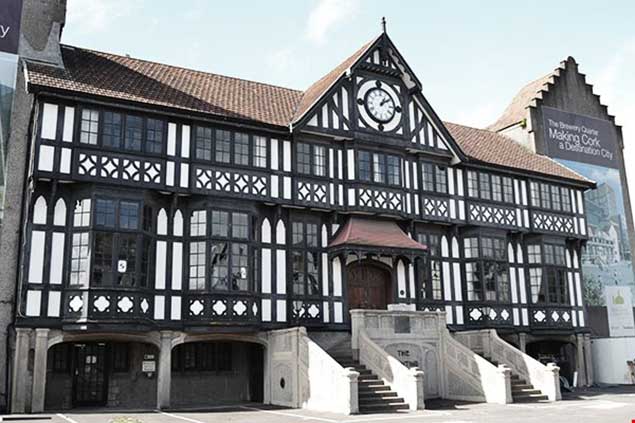 The distinctive Beamish & Crawford Counting House in Cork was built in 1918 during Arthur Sharman Crawford’s long period as Managing Director of the brewery
The distinctive Beamish & Crawford Counting House in Cork was built in 1918 during Arthur Sharman Crawford’s long period as Managing Director of the brewery
There was a very pointed irony in the brothers’ relationship, for even as the brewery in Cork prospered under Arthur’s stewardship, the inherited income from the Crawford estates in the north was shrinking thanks to longterm effects of the activities of Michael Davitt’s Land League and the resultant Gladstone-inspired Land Acts of 1896. The dividends from Cork became an increasingly important part of Robert Sharman Crawford’s income to maintain his opulent lifestyle as a leading yachtsman and as Lord of the Manor of the new loughside Crawfordsburn House, built in the late 1890s to the designs of Vincent Craig. He was the architect brother of Northern Ireland’s future first Prime Minister James Craig (another sailing enthusiast), and his considerable architectural talents were at the same time being deployed for the design of the new Royal Ulster Yacht Club building, which opened in April 1899.
By 1912 and the public declaration of the Ulster Covenant with Robert Sharman Crawford a leading signatory, the fact is that his way of life was largely supported by Beamish & Crawford dividends. It seems only ironic in hindsight – at the time, everyone on all sides though they were doing the right thing. It is only in looking back from the distant and safe viewpoint of 2017 that we realise how curious it was that 104 years ago in 1913, when Colonel Robert Sharman Crawford put his own-funded brigade of the Ulster Volunteer Force through their parades, manoeuvres and exercises on the lawns and fields of Crawfordsburn House, it was all being largely paid for by the continued devotion of the Beamish stout drinkers of Munster.
Yet in that dreamlike pre-World War I era, such activities still seemed slightly theatrical and unreal, and normal life went on at an even more determinedly enthusiastic pace than ever. Having finally agreed a Measurement Rule with the defenders, early in 1914 Thomas Lipton’s latest America’s Cup Challenger, the Charles E Nicholson-designed Shamrock IV, was nearing completion in the south of England. And in the Fife yard in Fairlie in Scotland, a new William Fife designed yacht with an experimental rig was under construction for Arthur Sharman Crawford.
For although Lipton’s technically advanced Shamrock IV carried a very sophisticated gaff rig, it was a gaff rig nevertheless. Thus Arthur Sharman Crawford’s new boat was more important in terms of overall technological development. A more manageable 8 Metre after several successful but demanding years with the 12 Metre Ierne, the new Ierne II was the first yacht to the International Rule of 1907 to set a Bermudan rig.
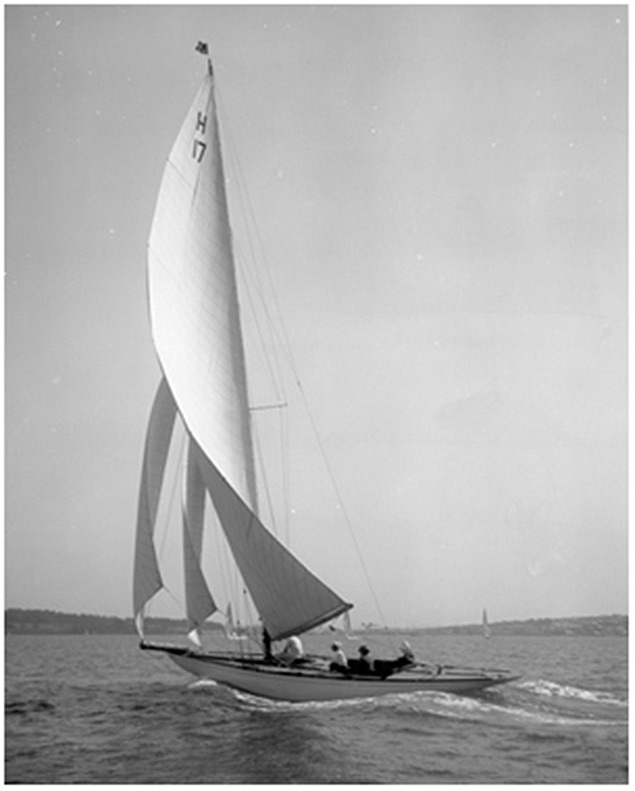 Arthur Sharman Crawford’s 8 Metre Ierne II in 1914, when she was the first International Rule yacht with Bermudan rig.
Arthur Sharman Crawford’s 8 Metre Ierne II in 1914, when she was the first International Rule yacht with Bermudan rig.
Why is she almost totally forgotten in Ireland? Well, Arthur Sharman Crawford led a sort of sailing double life, or even treble life. At home in Cork Harbour, his sailing was local, often using local boats. On Dublin Bay and particularly in Belfast Lough, he was associated with the Lipton camp. But on the Clyde or in the Solent, he was the international or even supra-national yachtsman Arthur Sharman Crawford, challenging the top talents at a rarefied level which was remote from the more localized approach of Cork Harbour or Belfast Lough, and at a tasteful remove from the razzmatazz of Lipton’s America’s Cup challenges.
So when Ierne II appeared fresh out of the wrappers to surprise everyone in the Solent in July 1914, she had never been anywhere near either Belfast Lough or Cork Harbour. It was in the Solent that she made her debut, and for a few very encouraging weeks, while she was undoubtedly a very different creature to sail than a gaff-rigged boat, she was out-performing them all to windward.
It’s intriguing to reflect that when Ierne II was being admired as the hottest new boat in Cowes in late July 1914, briefly in the same harbour at the same time we would have seen Erskine & Molly Childers’ Asgard and Conor O’Brien’s Kelpie pretending to be leisurely cruisers going gently about their business, when in fact they were bound for the Ruytigen Lightvessel to collect their cargoes of Mauser rifles.
Within a couple of weeks, everyone’s plans were in disarray with the outbreak of World War I. All the key figures in the Asgard/Kelpie adventure quickly found themselves positions with the Allied Forces. As for Arthur Sharman Crawford, at the age of 52 this was not an immediate consideration, but his plans for a new programme of fresh excitement for a keen yachtsman past what was then considered the prime of life simply evaporated. Cowes Week 1914 was cancelled completely, and Ierne II was denied the stage which would have provided the setting to enable her to claim her rightful place in sailing history.
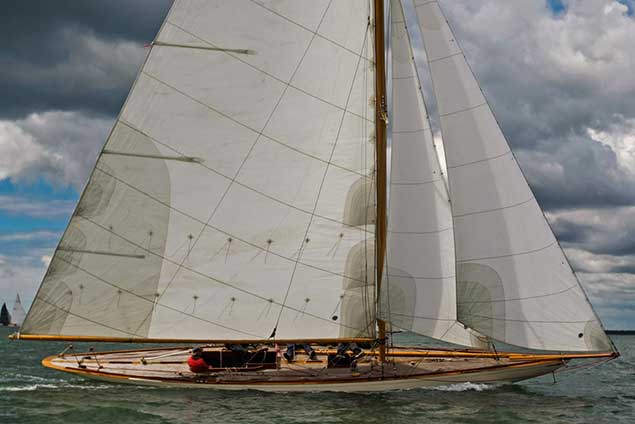 The restored 8 Metre Ierne II is a vivid reminder of Arthur Sharman Crawford’s pioneering instincts.
The restored 8 Metre Ierne II is a vivid reminder of Arthur Sharman Crawford’s pioneering instincts.
Indeed, it was only when noted Yorkshire sailor Hew Jones spotted her laid up in Portugal in 2005 and set about a restoration on Humberside that the whole astonishing story was revealed. When World War II ended in 1918, anyone running a business in Cork amidst Ireland’s growing troubles had other things on his mind, and Arthur Sharman Crawford put Ierne II – laid up since the beginning of August 2014 – on the market. She was eventually bought by Norwegians who wanted a boat for the 8 Metre Class in he 1920 Olympic games in Belgium, and they struck gold in every way, as Ierne II won the Gold Medal.
The top racing sailors were increasingly convinced that Bermudan rig would be where it was at, but in the post war recession, progress was slow. Nevertheless, it was another Irish owner who led the way in the south of England. Elizabeth Workman was the widow of one of the founders of the Workman Clark shipyard in Belfast, and as they at least had done well out of the war, she had the resources to re-commission her 112ft gaff cutter Nyria, designed by Charles E Nicholson and built by Camper & Nicholson in 1906.
Nyria was Solent-based, and following the success of Ierne II and other newly-Bermuda rigged smaller boats in the 1920 Olympics, Elizabeth Workman took the mighty step of getting Charles Nicholson to kit out Nyria with Bermudan rig for the 1921 season, making this the first internationally recognized “big yacht” to do so.
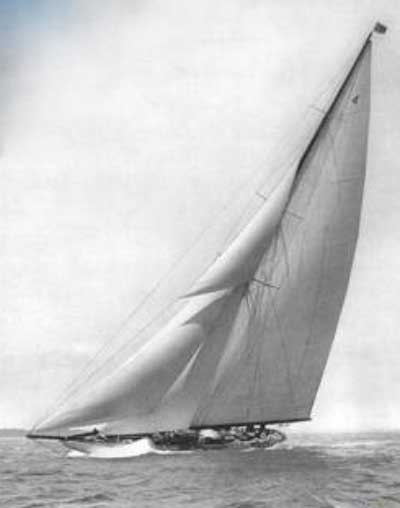 Nyria, owned by Elizabeth Workman of Belfast, in 1921 became the first “big yacht” to be kitted with Bermudan rig
Nyria, owned by Elizabeth Workman of Belfast, in 1921 became the first “big yacht” to be kitted with Bermudan rig
The corner towards Bermudan rig was being turned, and yet another impulse came from Ireland , this time with the commissioning of the world’s first Bermudan-rigged One Design class. The lively Belfast Lough sailing scene of 1914 had been largely destroyed in the trenches of the Somme by the time peace returned in 1918. In an exchange of letters in 1919, some of the more senior members of the Royal Ulster wrote about the need for a new class of boat “which could be sailed by a man and his daughters”. Far from being a gesture for women’s rights, this was simply a sad admission that so many young sailing men would never return from Flanders fields and northern France that it would be 1925 where anything approaching normal manpower levels in sailing would be regained, and so in 1921 the Alfred Mylne-designed Bermudan-rigged 29ft River class made their appearance on Befast Lough. They have never known any rig other than Bermudan, and they continue racing today, though now based on Strangford Lough.
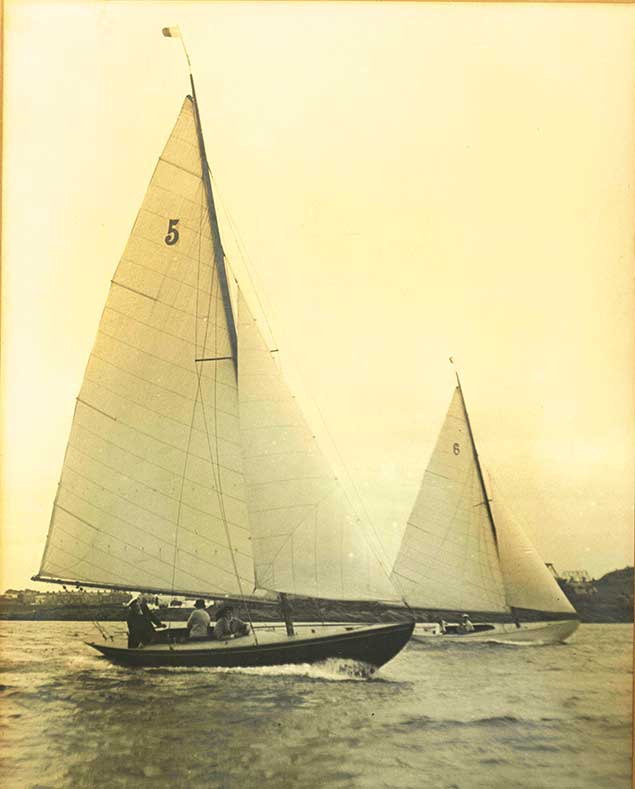 The River Class, seen here racing in Befast Lough in 1921, were the world’s first Bermudan-rigged One Designs.
The River Class, seen here racing in Befast Lough in 1921, were the world’s first Bermudan-rigged One Designs.
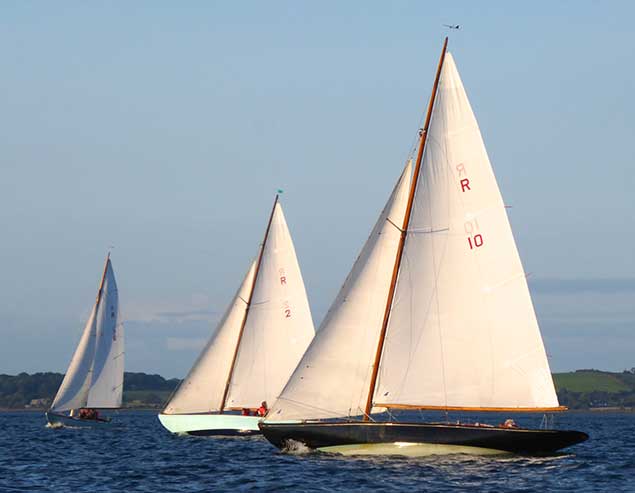 The River Class as they are today in Strangford Lough after 96 years of setting Bermudan rig
The River Class as they are today in Strangford Lough after 96 years of setting Bermudan rig
Thereafter, the move towards Bermuda rig was inexorable and seemingly irreversible, even though sailors as experienced as Billy Mooney of Dublin were ordering the gaff rigged ketch 42ft Aideen to be built by Tyrell’s of Arklow in 1934, and he sailed her so well that he won his class in the 1947 Fastnet Race.
But others were more restless. Since 1898 the gaff-rigged Howth 17s had been sporting their jackyard topsails at their home port north of Dublin, and in 1907 the Dublin Bay Sailing Club adopted the same design, and proprietorially re-designated them as the Dublin Bay 17s. Not only that, but in 1936 a young and competitively successful Dun Laoghaire owner, Terry Roche, decided he would lead the way by converting his DBSC 17 Eileen to Bermudan rig. Despite the fact that she now carried lee helm as he would also have had to move the mast aft to make the new rig balance, he doggedly sailed her to Holyhead and back to prove that all was well. But nobody followed his lead, and after this rather expensive experiment, Eileen reverted to gaff rig and successful racing the following year, and the only lasting memorial of this project is the quaint photo of the Dun Laoghaire waterfront in 1936, a classic image worthy of Cartier-Bresson, with the Water Wags racing off the Royal Irish YC beyond, while in the left of the photo is Eileen sailing under Bermudan rig using mainsail only, which probably balanced quite nicely.
 A quirky photo worthy of Henri Cartier-Bresson. The waterfront at Dun Laoghaire in the summer of 1936, with the Water Wags beyond racing off the Royal Irish YC, and on the left Terry Roche’s Howth/Dublin Bay 17 Eileen in her brief but expensive flirtation with Bermudan rig.Photo courtesy Hilary Keatinge-Roche
A quirky photo worthy of Henri Cartier-Bresson. The waterfront at Dun Laoghaire in the summer of 1936, with the Water Wags beyond racing off the Royal Irish YC, and on the left Terry Roche’s Howth/Dublin Bay 17 Eileen in her brief but expensive flirtation with Bermudan rig.Photo courtesy Hilary Keatinge-Roche
 Howth 17s at Dun Laoghaire again, but this time rigged as nature intended, complete with jackyard topsails. Photo VDLR
Howth 17s at Dun Laoghaire again, but this time rigged as nature intended, complete with jackyard topsails. Photo VDLR
Yet other classes such as the Belfast Lough Island class yawls changed to Bermudan rig in the 1930s, but in Dublin Bay the honour of the gaff rig was stubbornly carried until 1963 by the Dublin Bay 21s, when after sixty years of gaff they converted to Bermudan rig which gave have them another 23 years of active racing life.
Typically of everyone being out of step except Dublin Bay, 1963 was also the very year in which the Old Gaffers Association was founded simply to preserve gaff rig. Ironically, gaff rig is now more visible than ever, albeit above plastic hulls. After all, there are more than a thousand gaff-rigged Cornish Shrimpers sailing the sea.
 Dublin Bay 21 in full gaff rig glory
Dublin Bay 21 in full gaff rig glory
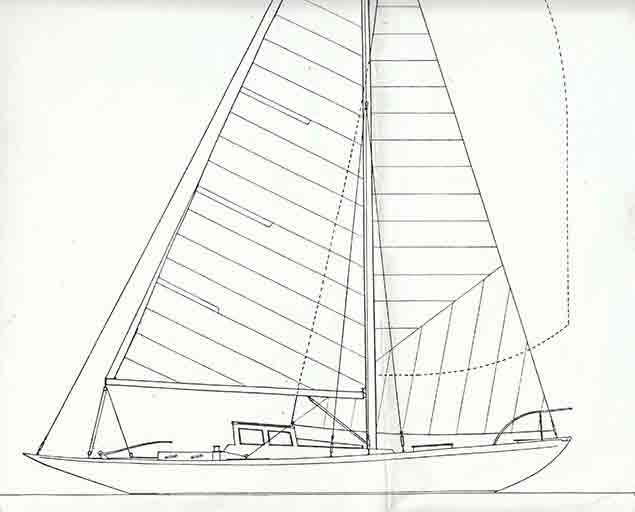 It is 1963, the Old Gaffers Association has just been formed, yet in Dun Laoghaire in 1963 the Dublin Bay 21s make their debut rigged like this……..
It is 1963, the Old Gaffers Association has just been formed, yet in Dun Laoghaire in 1963 the Dublin Bay 21s make their debut rigged like this……..
So is it coming full circle? Maybe. After all, when the America’s Cup multi-hulls start strutting their stuff on Great Sound in Bermuda, they’ll be setting square-headed mainsails which are gaff rig in any sensible definition. And all that where Bermuda rig as we knew it for so long originated more than 183 years ago……
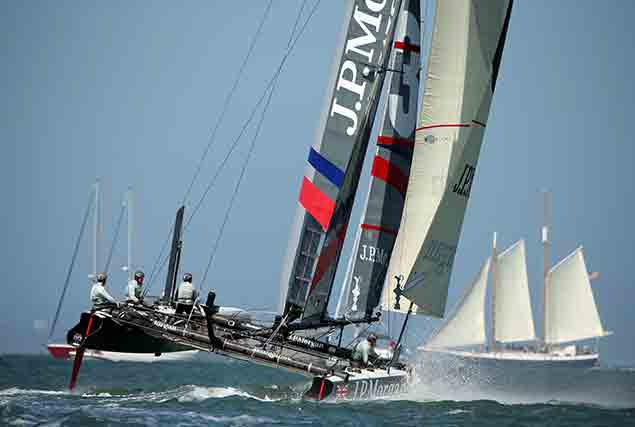 When gaffers meet….one of Ben Ainslie’s America’s Cup boats making knots towards another old gaffer
When gaffers meet….one of Ben Ainslie’s America’s Cup boats making knots towards another old gaffer
But the real test is on Cork Harbour. The reversion to gaff rig came centre stage there last year when the new Ultra National 18s decided the only way to make their otherwise state-of-the-art boats truly sexy was to give them trendy square-topped mainsails.
And if by any chance the spirit of Arthur Sharman Crawford still sails about Cork Harbour, the place he came to love so well, I’ve no doubt he’ll be doing it aboard a ghostly Ierne XXX under a spectral square-topped mainsail, occasionally waxing nostalgic about the old days when he sailed Ierne II with a quaint three-sided mainsail.
 Being fashionable. In 2016, the National 18s Ultras in Cork Harbour reverted to “gaff rig”.
Being fashionable. In 2016, the National 18s Ultras in Cork Harbour reverted to “gaff rig”.
Afloat.ie’s W M Nixon grabbed only a few hours sleep after his almost continuous coverage of the Volvo Round Ireland Race 2016 before haring off to Bangor in County Down to sail in the RUYC 150th Anniversary Regatta on Saturday June 25th aboard the same boat on which he took part in the same club’s Centenary Regatta in 1966 – and with the same crew. But he arrived at his former home port to find that the defining sailing symbols of his more recent home port of Howth had got there before him…
The amateur yacht designer Walter Boyd of Howth crewed on his father’s 72ft cutter Thalia in the Royal Ulster Yacht Club regatta at Bangor on Belfast Lough in July 1897. A week earlier, the Boyd family had concluded their accumulation of tidy sums in prize money in the Clyde Fortnight with the 1891-vintage Fife-designed Thalia. Ironically, Thalia had been sold away from the Clyde to Judge Boyd of Howth in 1892 at a bargain price, as her original Scottish owners felt she was being out-classed by the new boats from the other Scottish designer, G L Watson. But the Boyd family seemed well able to demonstrate otherwise.
Certainly by 1897 it was Fife who was again in vogue with newer winners like Isolde and Ailsa, and that year saw the advent of the new Fife-designed Belfast Lough One Design Association 25ft LWL Class I boats, built by up-and-coming boatbuilder John Hilditch of Carrickfergus on the north shore of Belfast Lough.
They made a very favourable impression on their debut at Clyde Fortnight in late June and early July 1897 closely observed by, among many others, the Boyd family on Thalia. And after returning to strut their stuff at home at the Royal Ulster regatta in mid-July, four of the BLOD 25s then went on to race for several days in the Dublin Bay regattas, making such a good showing that it inspired the formation of the Dublin Bay 25ft OD Class.
The Dublin boats, with the first appearing in 1898, were of the same hull profile, but with slightly finer sections and built to a much higher specification, with a lead ballast keel as opposed to the Belfast Lough boat’s cheap-and-cheerful cast iron.
Yet even while the pundits of the Clyde, Belfast Lough and Dublin Bay were debating the merits of one against the other, and indeed whether it was even a feasible idea to have a One Design of such a size that she was capable of going offshore, the Howth men returned to their peninsula home, and cogitated among themselves on what they had seen. They were looking for something economical to replace the deathtraps which were the Half Raters they’d been racing for three or four seasons.
Bangor Marina with some of the Mylne-designed Glens from Strangford Lough in the foreground, and jackyard topsails much in evidence on the Howth 17s beyond as they prepare to race across Belfast Lough to their 1898 birthplace of Carrickfergus. Photo: Trish Nixon
The result was that by the end of October 1897, Walter Boyd had produced a design for an able little 17ft LWL, 22.5ft LOA gaff sloop complete with jackyard topsail. An order to build the first five was immediately placed with John Hilditch at Carrickfergus. And by the beginning of April 1898, these new Howth 17s were ready to be sailed the 90 miles to their home port by their notably keen owners. From design finalisation to first race took barely six months, which tells us much about the spirit of the 1890s.
The world has moved on since 1898, but there is still a numerous class of Howth 17s at Howth, including the original five built by John Hilditch at Carrickfergus. In 1998 a flotilla of them returned by road to their birthplace for some decidedly crisp Easter sailing to celebrate their Centenary, and then – the wind being fair – they all made a fast if freezing overnight sailing passage home.
The Return of the Seventeens – approaching Carrickfergus SC on June 23rd 2016, Ian Malcolm’s Hilditch-built Aura (7) leads from Roddy Cooper’s Leila (3, also Hilditch-built) while third lies Class Captain Tom Houlihan in the 1899-built Zaida. Photo: Trish Nixon
Since then, they’ve had further outings to various classic events, with a couple even managing Brest on one occasion, and the Solent Classics on another. But their most impressive outing was in 2003 when no less than 15 boats were moved in a masterclass of logistics to the Glandore Classics. So although the regular annual race programme, which provides them with sixty races each summer at Howth, is the backbone of the class, now and again other possibilities turn up, and for 2016 there was a double offering on Belfast Lough.
There, sailing seems to have suddenly taken off in 1866, as 2016 offered both the 150th Anniversary of Carrickfergus Sailing Club with a special Hilditch Regatta to celebrate the memory of a boatbuilder who was in business for only 24 years from 1889 to 1913, but he was very productive during those years. And it was also the 150th Anniversary – the Sesquicentennial, forsooth – of the Royal Ulster Yacht Club, which had started life as the Ulster Yacht Club in 1866, but thanks to having Lord Dufferin of high latitudes cruising fame as Commodore, by 1869 they’d the Royal warrant.
Yet when the Howth 17s’ designer raced with his father and siblings aboard the Thalia at Bangor in 1897, the RUYC was still modestly housed in a rented semi-detached house – a big semi-detached house admittedly – above the Bangor seafront. So although the Belfast Lough season of 1898 had still not begun when the new Howth 17s sailed past homeward bound in April 1898, there was a flurry of building work under way on the Bangor waterfront, as RUYC had acquired an important new member, and he required the club to have a proper clubhouse to provide a base for a project he had in mind.
First time together – the RNIYC Fairy Class, built by John Hilditch in 1902, get together in Carrickfergus with the Howth 17s (built Hilditch 1898) Photo: Trish Nixon
The new member was Thomas Lipton, already a multi-millionaire with a rapidly expanding grocery empire. His ambition was to challenge for the America’s Cup, and his notions of grandeur chimed well with the feelings of a significant group of the RUYC membership, who felt that a rented semi-detached house, despite its desirable seafront location, was no longer adequate for their rapidly rising status in the world of yachting.
A mid-season meeting of RUYC members in 1897 had already decided that a new clubhouse be built, and architect Vincent Craig – a keen sailing man – soon produced an Arts & Crafts-inspired design with a hint of the Scottish baronial for the selected dominant site. The whole extraordinary confection of a building, with a sort of inspired “instant antiquity” in the mood it created, was built in 18 months, with the opening in April 1899. As we were suggesting earlier, things got done – and done quickly – in Belfast Lough in the 1890s.
The 1899-completed clubhouse of the RUYC was built in a near-record time of 18 months. Photo: W M Nixon
Since then, Thomas Lipton’s five America’s Cup challenges have come and gone, and though he never won, he was definitely a serious contender in 1901 and 1914. World wars have since been fought, empires have disappeared, the global map has changed, and the world structures of sailing have been re-configured. Yet the Royal Ulster YC’s history-laden clubhouse continues to brood above the Bangor waterfront. And the Howth 17s remain unchanged at Howth. They and the RUYC clubhouse are almost exactly the same age. Clearly, the Sesquicentennial Regatta offered a very special opportunity for these two relics of old decency to get together for the very first time.
Of course, there was far more to the events of this past week and more on Belfast Lough than this. But when a 118-year-old class is kept in good order in one place, and a 117-year-old clubhouse of real character is lovingly maintained in another, there’s every possibility of an interesting chemical reaction when the two get together.
But for me, interest in this event was in another direction entirely, for 1966 was the last year in which most of my sailing was Belfast Lough-based. I tended to head south thereafter, soon re-locating in Howth. But for the Centenary Year of 1966, it was Belfast Lough and RUYC virtually all the way, and as on many occasions during the 1960s, there was a June cruise with the chartered 9-ton yawl Ainmara – designed and built by John Kearney of Ringsend in Dublin in 1912 – to West Cork.
It was the first proper sailing visit to West Cork, for though we’d called at Baltimore while coming in from the west coast during an anti-clockwise round Ireland cruise with Ainmara in 1964, for 1966 we lingered on in summer somnolence (remember when summers had somnolence?) in sweet places like Glandore and Castlehaven when they were decidedly less crowded than they are today.
The only time limit on this easy-going venture was to get Ainmara back to Belfast Lough in time for the Centenary Regatta of the RUYC at the end of June 1966, for the old girl (we already thought of her as very old in 1966) had recently passed into the ownership of Dickie Gomes, and as an RUYC member and very proud of his newly-acquired boat, this was definitely a must-do fixture.
The day itself was one of a sunny though not overstrong nor’easterly, but as it would have set up an awkward little popple in the Belfast Lough sea state, Ainmara was not at her best against more modern boats in the windward work. So although there’s a medallion on the bulkhead in Ainmara’s saloon to commemorate her participation in this Centenary Regatta, fifty years later neither Dickie Gomes nor his wife Deirdre nor I – all of us on board at the time – have any idea of our result, but we’re reasonably sure it wasn’t a win, so blessed amnesia has been at work in the intervening fifty years.
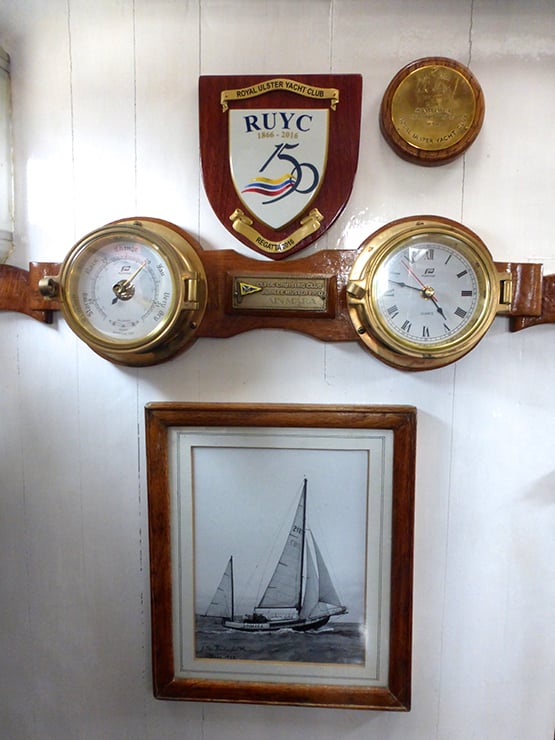
The saloon bulkhead in Ainmara now has the addition of the 150th Anniversary plaque. The medallion top right commemorates the RUYC Centenary Regatta of 1966, between the clock and the barometer is a smaller plaque commemorating participation in the Clyde Cruising Club’s Golden Jubilee Cruise-in-Company in 1969, and the photo is of Ainmara at the start of the CCC’s 1972 race from Inverness across the North Sea to Norway. Photo: W M Nixon
During those same fifty years, while Dickie kept on with Ainmara and did many things with her, including racing to Norway and cruising to the Outer Hebrides and southern Brittany and notching success in many North Channel offshore races, he also spread his wings in many other sailing directions. In 1982 he and sailing friend Brian Law built the 40ft Dick Newick trimaran Downtown Flyer with which they scored a raft of successes in events up to the international Round Britain and Ireland level, and in 1986 – in November, no less - he established a new Round Ireland Record with the 83ft catamaran Novanet. This record stood until Steve Fossett came along to snatch it with the trimaran Lakota in September 1993, and then in 1988 Dickie Gomes found himself back in mono-hulls, in command of Brian Buchanan’s Frers 49 Hesperia (she’s now Jamie Young’s Killary Flyer down in north Connemara), and was overall winner of the 1988 Round Ireland Race.
This successful relationship with Hesperia became a feature of the sailing scene for many years, and during this period Ainmara was resting in a shed at Dickie and Deirdre’s farm in the Ards Peninsula in east County Down, awaiting repairs and refurbishment after breaking from her moorings in Strangford Lough in a winter storm. But she’s a tough old bird, John Kearney built her well, she was well worth restoring, and there was never any doubt that, whatever the other distractions, she’d be sailing again for her own Centenary in 2012.
She was out and about again in 2011, her Centenary in 2012 was then marked with a celebratory cruise to the Outer Hebrides, and in 2013 she played a starring role in the Golden Jubilee Celebrations of the Old Gaffers Association, adorned with prizes too, for although Ainmara has been Bermudan-rigged since the 1930s, she’s revered as an honorary gaffer.
Tom Houlihan’s Howth 17 Zaida off Bangor. Photo: Trish Nixon
The Sesquicentennial Parade of sail was a real floating come-all-ye, with Toppers and other dinghies mixing it with Howth 17s such as the award-wining Gladys (14) and modern cruiser-racers. Photo: Betty Armstrong
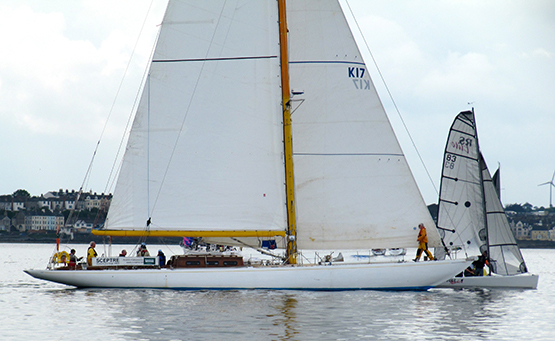
History afloat. The 1958 America’s Cup Challenger Sceptre off Bangor with an RS Elite. There’s more to this than meets the eye – the RS Elite is Phil Morrison’s miniaturized take on the special America’s Cup Class which succeeded the 12 Metres such as Sceptre as the boat of choice in AC racing. Photo: Betty Armstrong
Thus the up-coming RUYC Sesquicentennial Regatta was seen as a celebration of many things, of friendships which have withstood the test of time for many decades, of wonderful old boats which continue to give great sport, and of a surreal clubhouse which had become increasingly irrelevant as sailing’s focus shifted to smaller boats with amateur crews, but then found a new role as a sort of living museum of sailing history when Bangor was provided with what was then Ireland’s largest marina in 1991. This elevated the old clubhouse on the hill into a sort of Temple of Sailing, where devotees of the more rugged versions of the sport can retreat to reflect on their experiences in a peaceful setting well away from the hurly-burly of the marina waterfront.
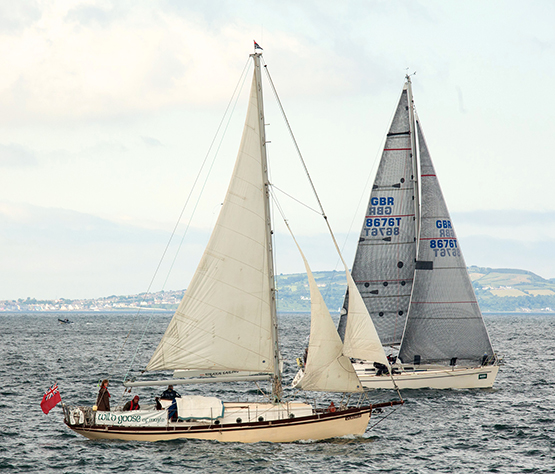
The RUYC Sesquicentennial attracted boats from every background. This is Wild Goose from Portrush, renowned in times past for her links with sailing writer Wallace Clark. She has been complete up-graded in a somewhat changed form by Robin Ruddock of Portrush, who brought her to Bangor to salute 150 years of Belfast Lough sailing. Photo: Andrew Gallagher
So how do you celebrate the 150th Anniversary of such a remarkable institution? It’s of special interest in Ireland, as we are already anticipating the 300th Anniversary of the Royal Cork Yacht Club in 2020. In Bangor, RUYC Vice Commodore Myles Lindsay and Rear Commodore Greg Taylor and their team put together an intensive four week programme which has seen a variety of events including the Sigma 33 Championship, a Classic Yacht Regatta, a 150th Anniversary Regatta which included a wide range of boats reflecting Belfast Lough and Ireland’s sailing’s diversity, while this weekend it is concluding with an assembly of the Cruising Clubs which will mercifully see the focus of activity move gracefully up the west coast of Scotland and into the Hebrides in a Cruise-in-Company which will enable them to pause for breath back in Bangor.
In tandem with this, the Hilditch Regatta at Carrickfergus drew in the Bangor-assembled boats on Thursday June 23rd for a good day of sailing, and for the first time ever it brought the Hilditch-built Howth Seventeens which had breezed in from Bangor together with the Hilditch-built (1902) Fairy Class from the Royal North of Ireland YC across the lough, plus sundry other craft including the Ainmara, without which no proper boat event in the north is complete.
Hal Sisk’s 1894-built Peggy Bawn returns to her birthplace of Carrickfergus in June 2016. Photo: Trish Nixon
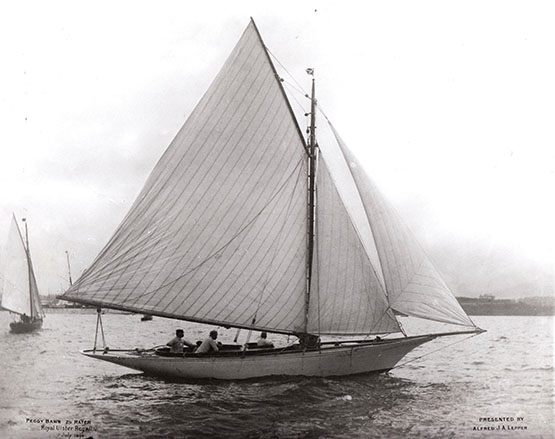
Peggy Bawn on Belfast Lough in 1894. Photo courtesy RUYC
However, by any standards the star of the show was Hal Sisk’s meticulously-restored G L Watson-designed 36ft Dun Laoghaire-based Peggy Bawn, a Hilditch-built cutter of 1894 vintage. While the Howth 17s are still as originally designed, although standards are rising every year they’re not all yet to classic yacht standards. As for the Fairy Class, they have been changed to Bermudan rig. And the old Ainmara and others like her are clearly not as originally designed. But Peggy Bawn is in a league of her own - she’s so authentic and exquisitely finished that it hurts.

Roddy Cooper’s Leila (built 1898) and the RUYC clubhouse (built 1899) get together for the first time. Photo: Betty Armstrong
The Howth Seventeens re-assembled back in Bangor to find they were seven in all, a gathering made easier - when you’ve only four road trailers - by the fact that the father of the class, Nick Massey, crewed by Dave Nixon, had sailed the 1907-built Deilginis from Howth to Bangor in two swift daylight stages, with a stop in Ardglass. They were now joined by six boats of the Glen Class which had sailed round from Strangford Lough, for although the Alfred Mylne-designed 25ft Glens – which originated in 1947 – are now found only in Strangford Lough and Dun Laoghaire, they began life as an RUYC Class, built in Bangor at the long-extinct Glen Boatyard on Smeltmill Bay to the west of the town.
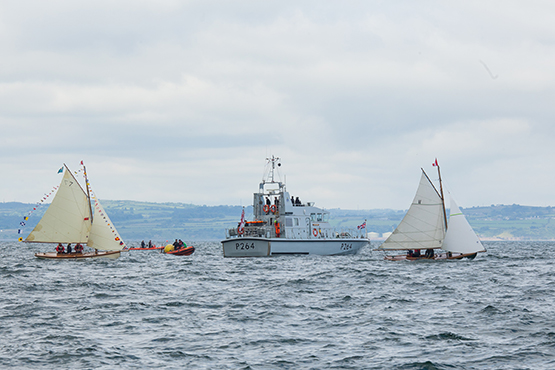
Howth 17 overall winner Aura (Ian Malcolm, left) and Deiliginis, which sailed from Howth to Bangor, parade past the guardship HMS Archer. Photo: Andrew Gallagher
Together with the restored local 18ft keelboats of the 1902 Waverley class in Bangor, there was now a comprehensive gathering of past and present to sail forth in the RUYC Sesquicentennial last Saturday. Your reporter arrived on board Ainmara in reasonable time to find the doughty skipper and his shipmate Brian Law dressing the old boat overall, while just across the pontoon was the 1958 America’s Cup Challenger, the 12 Metre Sceptre, on one of her regular outings from the north of England. And across the way was Dutch skipper Ben Korner’s Open 40 Masai, recently retired from the Volvo Round Ireland Race thanks to a broken forestay fitting, hugely frustrating as they’d been in a splendid battle through the North Channel against RORC Commodore Michael Boyd’s First 44.7 Lisa, which went on to place third overall.
At this stage of the day there still seemed a chance of some lasting sunlight, but as Ireland was plumb under the malign influence jetstream, weatherwise it was a day of everything except what you wanted. But in terms of a reunion it was perfect, as I sailed again with Dickie and Deirdre Gomes, and our crew was joined by Jervis “Jess” Fleming home in holiday from West Australia – last time we sailed together, it was on that early June cruise of 1966 in Ainmara to West Cork.
With winds fluking around between northwest and northeast and sudden gusts coming from everywhere, the water of Belfast Lough were in a horrible popple which was a death knell for Ainmara’s afternoon racing hopes, but first there was the main part of the programme, the Sesquicentennial Parade of Sail, and for that the breeze was in brisk form.
Doughty skipper Dickie Gomes (age undisclosed) takes to the bowsprit to clear Ainmara’s jib topsail, while Deirdre Gomes (back to camera) and Jervis Fleming, both of whom sailed on the boat in 1966, get ready to tail on the halyard. Photo: W M Nixon
In fact, if it hadn’t been a Parade, we wouldn’t have dreamt of sending up our jib topsail. But our doughty skipper – whose chronological age is a secret, he’s permanently 25 in apparent terms – was soon out on the bowsprit clearing it for hoisting, the motley crew got it aloft, and in the nick of time the old girl was roaring along at full chat to cross the line in top style – even her bunting looked its very best.
As for the racing, we had our moments, but were stopped still for too long, while newer boats glided ahead, to figure in any prize-worthy placings. But frustration was soon allayed by a fresh new nor’wester which we enjoyed so much we sailed an entirely superfluous circuit of the course, and then back in the berth the old saloon was so comfortable and filled with memories that we yarned well past the time when we should have been up in the club for the official events. But we touched base there in time for our skipper to get his prize as Best in Show, which was all due to that last-minute full blossoming of the jib topsail just as the old girl came roaring up to the parade area inside the Royal Navy’s HMS Archer.
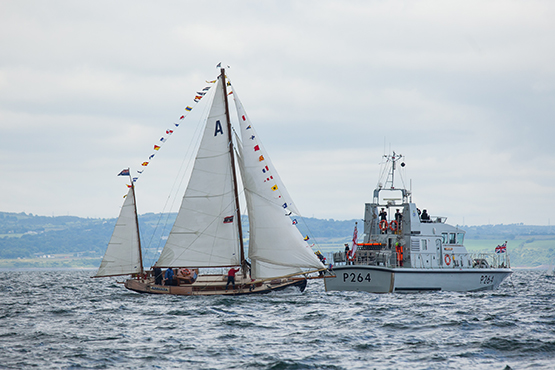
Made it in the nick of time……Everything up and drawing as Ainmara sweeps past the Guardship. Photo: Andrew Gallagher
The Howth 17 crews were made welcome and made themselves very much at home in the RUYC clubhouse. Photo: W M Nixon
So fifty years after the Centenary Regatta, Ainmara’s participation in the RUYC Sesquicentennial Regatta had hit the jackpot. The high was maintained all evening amidst much banter from the Howth 17 crowd, who had made themselves thoroughly at home in RUYC, with Ian Malcolm’s Hilditch-built Aura reckoned the best performer, though the 1907-built Gladys (Pat Heydon, Ian Byrne and Eddy Ferris) got the award for best-dressed overall. As Ian Byrne revealed, they’d gone to the trouble of putting their signal flags in the approved naval order, and these things count when you’re celebrating a 150th birthday.
The One-Designs had another day’s racing on the Sunday, but our job was done, and we’d to get Ainmara home to her secret place among the islands of Strangford Lough. As all the Howth 17s were going to be road-trailed home, Paddy Cronin with the 36ft Westerly Conway Aquarius of Howth was no longer needed as mother-ship, so we were his pilot veseel in an effortless if damp passage down the County Down coast, through Strangford Narows with the surging flood tide, and on along a winding route to Ballydorn, where the snuggest of berths was shared at the pontoon at Down Cruising Club’s lightship headquarters. It was a good end to some very special days.
The weekend comes to a close in a very special place. Ainmara with Aquarius of Howth berthed alongside the Down Cruising Club’s pontoon at its lightship headquarters at Ballydorn in Strangford Lough. Photo: W M Nixon
Royal Ulster Yacht Club's Sesquicentennial Regatta Weekend
At Royal Ulster Yacht Club over 80 boats gathered off Bangor on Saturday to take part in the 150th Anniversary Sail Past.
It was the latest event in June's RUYC Sesquicentennial celebrations. Previously, as Afloat.ie reported, the club welcomed HRH The Princess Royal to the Club. The occasion was a lunch in conjunction with the Royal Yachting Association of which Princess Anne is President.
150th celebrations got underway on June 20th when the club staged the British Sigma 33 Britsh and Irish Championships.
The sail past was presided over by Mr David Lindsay, Lord Lieutenant of Down with all the yachts sailing or motoring past the Club between the shore and HMS Archer. Nearly every yacht, motorboat and dinghy was dressed overall to make the occasion colourful. There were some outstanding sights such as Dickie Gomes' Ain Mara under sail and fully dressed overall who won the prize for Best Dressed large boat. The fleet of Glen Class yachts from Strangford Lough Yacht Club, returning to Bangor where they were built over fifty years ago. Seven members of the Howth 17 one-design class from Howth attended - these boats were originally built in 1897. Howth 17 No 14, Gladys won Best Dressed Overall Small Boat.
The 150th Anniversary Templeton Robinson Regatta followed the Sail Past with the boats competing over a course from Ballyholme Bay towards the Harbour. Mixed wind patterns made for difficult racing for some but everyone did enjoy the special day on the water.
Class Winners:
Class 1 - Mini Mumm - Flannigan Family RUYC/BYC
Class 2 - Bad - Steve Atkinson - CSC
RS Elites - Storm - Messrs Gunning, Kelso and McKee RUYC
Class 4 - Mingulay - Ritchie Family RUYC
Class 5 - Hecla - K Walsh -CIBC/DSC
Class 6 - Wild Goose II - A Armour - CIBC
Glens - Glen Lark - R Aiken - SLYC
Howth 17s - Aura - A Foster - Howth YC
Class 10 - Oliver Haig - Topper
Class 12 - Robert Milligan - RS200
Class 13 - N Strain - RS400
Honouring a tradition of Belfast Lough sailing which can be traced back to its foundation in 1866 and beyond, the Royal Ulster YC at Bangor on Belfast Lough began its four week “Sesquicentennial Sailing Celebrations” over the weekend with the British & Irish Sigma 33 Championships.
Three days of good racing on the open waters of Belfast Lough were enjoyed by nineteen Sigma 33s, which continue to have significant strongholds in the Firth of Clyde, as well as enthusiastic local small groups at many other ports. Ten races were scheduled, and despite varying winds and weather over the event, all ten were fully completed by a fleet drawn from Cornwall, Liverpool, Dunmore East, the Isle of Man, Glenarm, Strangford Lough and points round the Clyde, together with Belfast Lough-based crews, for the Class’s biggest event of the year.
The racing was close such that seven races on Friday and Saturday produced six winners. Bangor based boat ‘Squawk’ (Emma and Paul Prentice) got the local fleet off to a good start with a win in Race 1. Eric Robertson and Alan Harper from Cove Sailing Club in Loch Long in Argyll won Race 2 in ‘Leaky Roof II’, and Mark Bradshaw and Jack Gallagher in ‘Busy Beaver’, also from Cove SC, took Race 3. In contention after two days was James Miller’s Mayrise from Helensburgh, the winner at the recent Silvers Scottish Series at Tarbert. Race winners on Saturday were ‘Busy Beaver’, Stephen Martin’s ‘Signet of Kip’ from Strangford Lough YC, Allan Lennox and Grant Simpson’s Miss Behavin from Helensburgh SC, and Griogair Whyte’s Close Encounters from Royal Northern and Clyde YC.
Signet of Kip (SLYC) was winner of the Irish Sigma 33 Championship – this is Stephen Martin and his crew from Strangford Lough YC
Sunday saw three races sailed in the only damp weather of the series, and the Bradshaw/Gallagher team on Busy Beaver continued in good form, taking honours in Races 8 & 9. It was left to the Class Chairman, Paul Prentice, and his crew in Squawk to finish the event the way they had started, with the win in Race 10.
SIGMA 33 UK CHAMPIONSHIP WINNER: Busy Beaver (Mark Bradshaw & Jack Gallagher), Cove Sailing Club, Loch Long
Runner Up: Mayrise (James Miller) Helensburgh Sailing Club.
IRISH SIGMA 33 CHAMPIONSHIP WINNER: Signet of Kip – Stephen Martin (Strangford Lough Yacht Club)
Runner Up: Squawk (Emma and Paul Prentice) Royal Ulster Yacht Club/Ballyholme Yacht Club.
The RUYC 150th Anniversary Programme continues this weekend with a thee day Classics Regatta from Friday 23rd to Sunday 25th June, in the midst of which on Saturday 24th June is the Sesquicentennial Regatta which will feature a Sailpast by classics and traditional boats, including varied craft from several Irish Sea and Clyde branches of the Old Gaffers Association.
Royal Ulster Yacht Club – 150 Years of Sailing Excellence
The first event of the 150th Anniversary celebrations for Royal Ulster Yacht Club at Bangor on Belfast Lough will take place from Friday 17th to Sunday 19th June. The Sigma 33 UK & Irish National Championships has attracted twenty boats from throughout the UK and Ireland. From Lough Swilly to Waterford, and from the Clyde to Falmouth taking in Liverpool and the Isle of Man on the way. The visitors will join the local boats for three days of racing on the open waters of Belfast Lough.
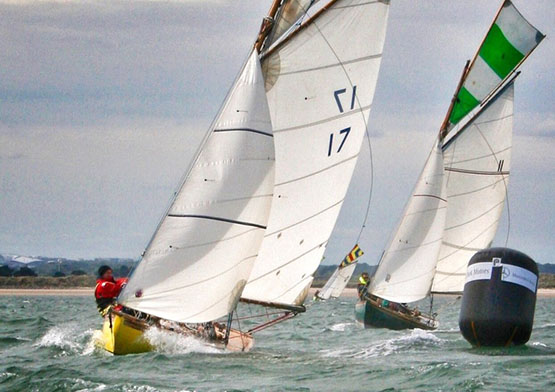
The Howth 17s – the first five of which were built on Belfast Lough in 1898 – will be travelling north to join the RUYC Classics Regatta from June 24th to 26th
Randox Health are also the title sponsor of our 150th Keelboat event with racing between Friday 24th and Sunday 25th June. This event has attracted not only local modern yachts but also some of the classics of the sport such as the Howth 17 Class from Howth, Dickie Gomes’ 103 year old yawl ‘Ain Mara’ which also took part in the RUYC Centenary Regatta back in 1966 , the G L Watson-designed Peggy Bawn, owned by Hal Sisk of Dun Laoghaire and built by John Hilditch of Carrickfergus in 1894, Ian Terreblanch’s ‘Trasnagh’ a 1913 Mylne-designed Island Class yawl also built by Hilditch, and the 1958 America’s Cup Challenger, the 12 Metre Sceptre.

Dickie Gomes’ 103-year old Ainmara will be taking part. She also raced in the RUYC Centenary regatta of 1966
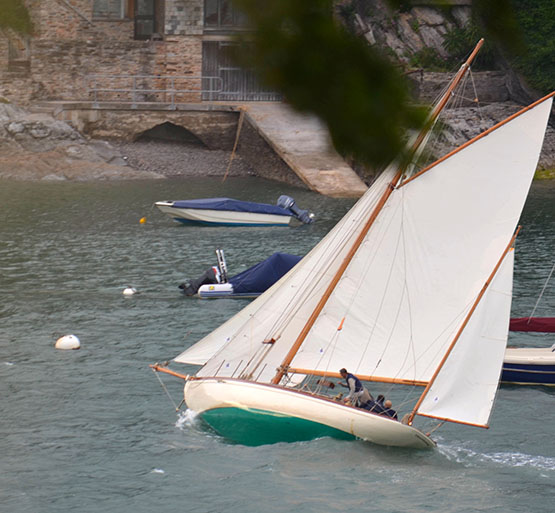
Ian Terreblanch’s 39ft gaff yawl Transnagh will be travelling north from Dartmouth in Devon to join the RUYC festivities. Originally she was built by John Hilditch of Carrickfergus in 1913 to be one of the Belfast Lough Island Class yawls

Hal Sisk’s G L Watson-designed Peggy Bawn – built by John Hilditch in 1894 – was a member of the RUYC fleet from 1898 to 1919
It is hoped to also have the Classic Mylne-designed River and Glen Classes from Strangford Lough Yacht Club also competing, as both these boats started their racing careers at Royal Ulster YC, together with other classics and Old Gaffers which are taking part in the Hilditch Regatta across the lough at Carrickfergus, but are shaping their course for Bangor on the Saturday (June 25th) when a highlight of the three day RUYC Regatta will be a Parade of Sail past the historic clubhouse from where Sir Thomas Lipton made his five Americas Cup challenges – all with racing yachts named Shamrock - between 1899 and 1930. The Sail Past will commence at 12.00 and will be followed by the Club’s Annual Regatta supported by Templeton Robinson.
The fortnight of celebrations – with Randox Health on board as title sponsor of the event – concludes on Friday 1st July with a Gala Dinner, following which a large gathering of cruising yachts which will have assembled in Bangor will be making their final preparations to depart on a 150th Anniversary Cruise-in-Company to the West Coast of Scotland jointly involving boats of the Clyde Cruising Club, the Irish Cruising Club, and the Royal Ulster Yacht Club.

The Royal Ulster YC clubhouse at Bangor



























